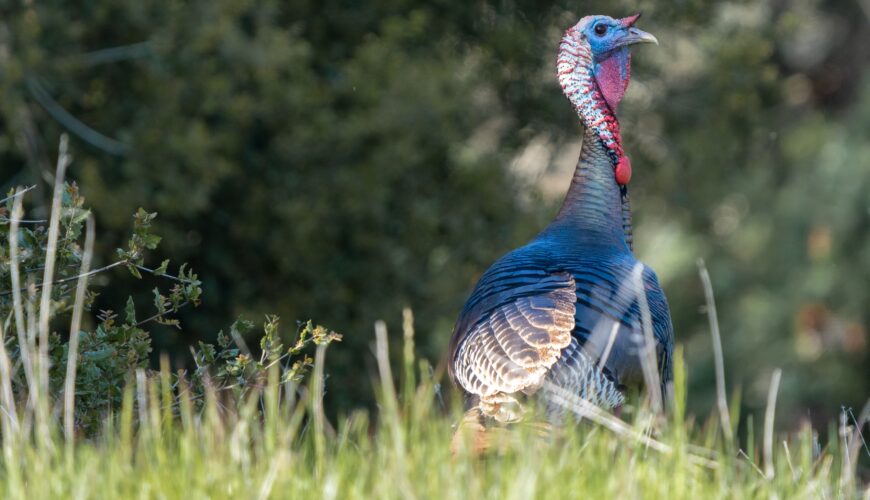Tactics
National Deer Association’s 5 Top Tips for Late-Season Deer Hunting
December 17, 2025 •iSportsman Staff
March 9, 2023
Turkey hunting has many challenges but one that is often overlooked is proper target acquisition. That problem can be resolved by choosing the right turkey gun sight.
Unlike other sporting birds that are shot while flying, turkeys are taken most often as they feed on the forest floor. The favored target is the brain and neck vertebrae as the turkey sticks its head up to investigate their surroundings. However, getting a proper sight picture on a target that bobs and weaves like an arcade whack-a-mole game can be almost impossible.
Even as forgiving as a shotgun can be, a miss is still a miss, and especially with the tight patterns that turkey chokes produce.
So how can we be assured that our shot will be perfect each and every time? Two obvious answers are getting to know the weapon and practice, practice, practice. The third and most important answer is choosing the correct sight, something that will get us on target fast and accurately with little or no error.

Standard shotguns come with just a bead near the muzzle and possibly another bead in the middle of the sight plane. It couldn’t be simpler. Line the beads up with the target and pull the trigger. Dead turkey. With all things being perfect, it would be that simple. However, in the excitement of the hunt, the shooter often doesn’t sight down the barrel the same way as they did in practice. Another problem is the fact that much of turkey hunting is going to be done in the dawn hours when the forest is still dark and filled with shadows. The small bead on the end of the barrel can get lost when aiming at a turkey in low-light conditions.
Other hunters go to the opposite extreme. Their guns sport low-power turkey scopes. Like other scopes it often magnifies the target allowing for better shot placement. The special bull’s-eye reticle also helps get the shot group dead center. While scopes seem like an ideal cure for all of a turkey hunter’s woes, it can bring up a whole different set of issues. The first being proper eye placement. Anyone that has used a scope knows what happens if your eye isn’t in the right plane, too far back, or worse yet, too close. Even setting at the range some hunters have a very difficult time acquiring the target because of improper eye/scope alignment. Unfortunately the shooter tends to creep up on the scope which can result a bloody eye socket which is exacerbated using heavy turkey loads. Another issue is tunnel vision. Most shooters close their off-eye when peering through a scope. Doing so makes the hunter oblivious to everything else around him or her.
The most common sight is the open sight. Sold by the millions across the USA, the glowing fiber optic versions seem like the perfect compromise. Simply line the green and red dots up with the turkey’s head, bang, dead turkey. If the turkey starts flying, no problem, just fall back on wing shooting skills and down he goes. What could go wrong? Nothing, if you’re an experienced shooter and practice. Most guides and experienced hunters I spoke with prefer these simple sights.
But, what if you’re not an experienced turkey hunter? Here’s what happens. Those same experienced guides told me the most common mistake with open sights is the shooter raising their cheek off the stock because that big black barrel kept them from seeing the turkey! With the way a turkey’s head bobs around as they move it is no wonder why a hunter has a good sight picture one moment and nothing but air the next. Even experienced turkey hunters can get excited and forget the basics.
So what is the best turkey hun sight? Many experts feel a red-dot scope is the answer. Turkey hunting guide and Mossy Oak Pro Staff manager, Darrin Campbell agrees. “The red dot scope is the absolute easiest. Put the red dot on the turkey’s red head and let the shot fly.”
I like easy. There are many different brands and styles of red dot scopes out there, but for my turkey gun, I went with the 42mm diameter red dot scope from Hawke Optics. The scope comes with Weaver rail scope mounts, has unlimited eye relief, and eleven brightness settings. With the extra large 42mm aperture target acquisition is fast. Plus, there’s no need to close the off eye. The hunter can stay focused on the target; see all of the target, plus its surroundings. It couldn’t be easier.
To prove it, I had my daughter, who had never fired a shotgun before, try my setup on a turkey target at thirty yards. The very first shot ever, the paper turkey target was perforated with ten B-Bs in the brain and spine area. That’s a dead bird on the first try!
That’s not to say a red dot is all sunshine and roses. There are two problems that hunters argue in this debate. The first is dead batteries. Some shooters forget to turn the red dot off. While the batteries have long life, they can’t be expected to last day after day being on twenty-four/seven.
The second problem is inclement weather. Rain drops on the glass can make the sight picture blurry, which is why scope covers were invented. Both of these problems can be overcome with a little forethought.
By choosing the turkey gun sight for your shotgun there will be one less thing to worry about when that big tom starts heading your way.
